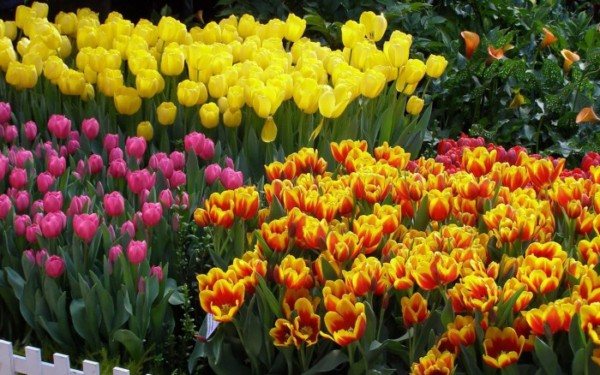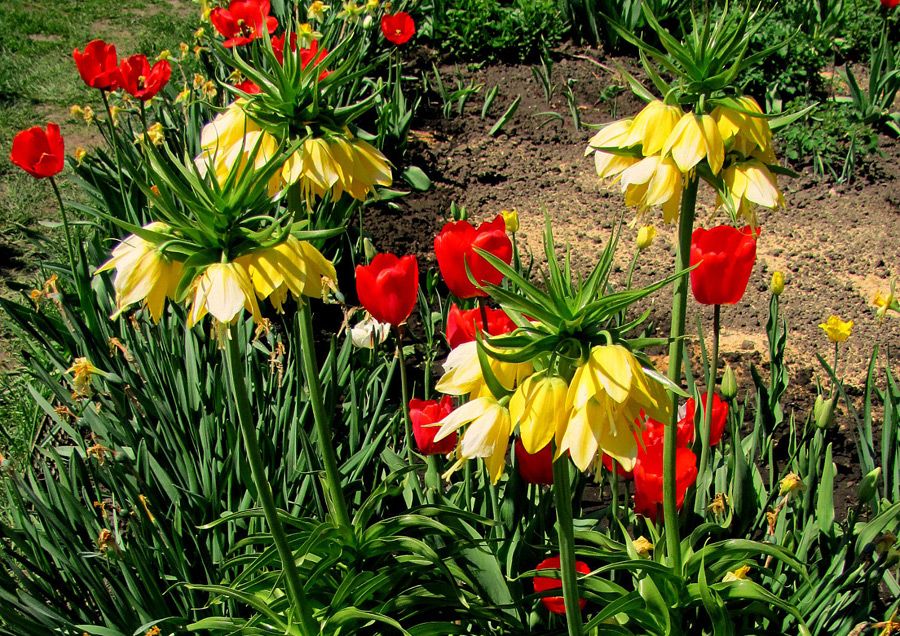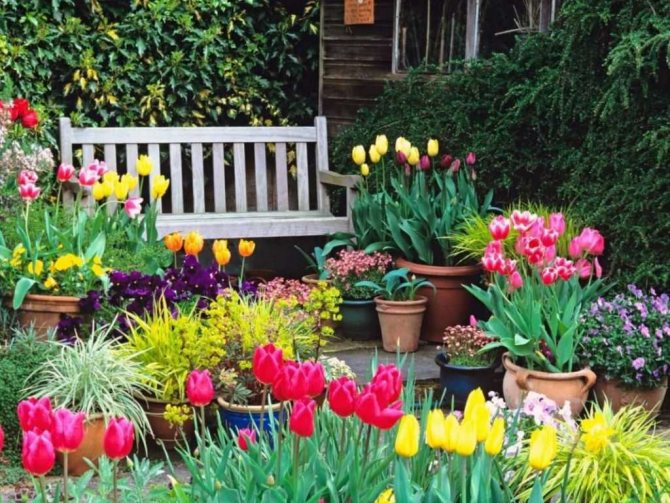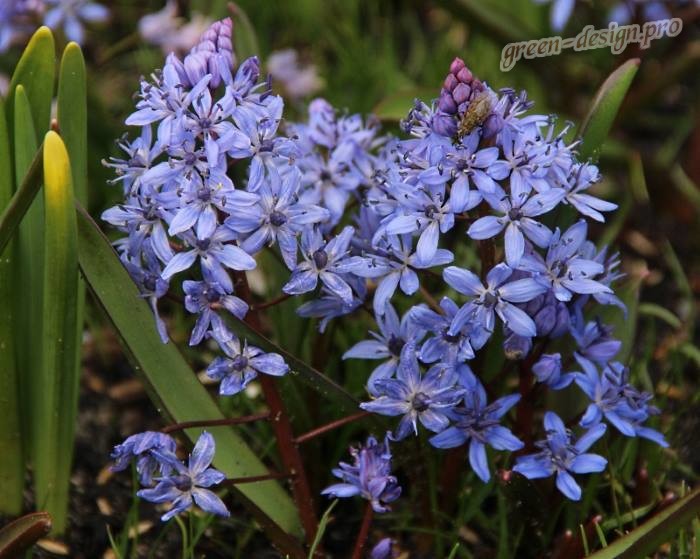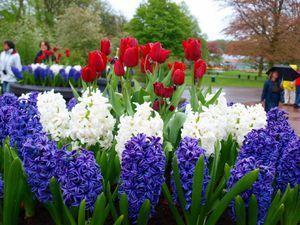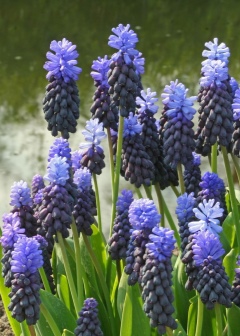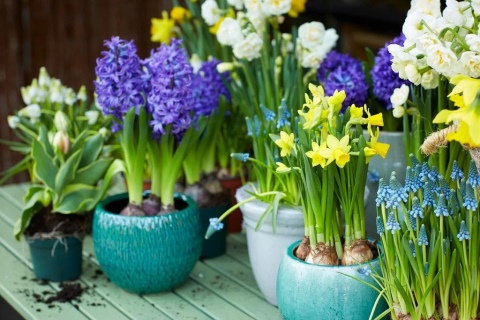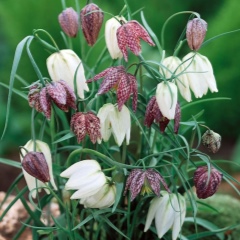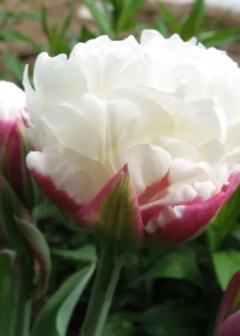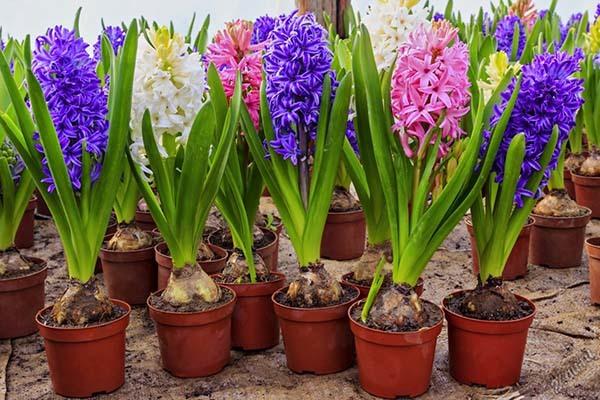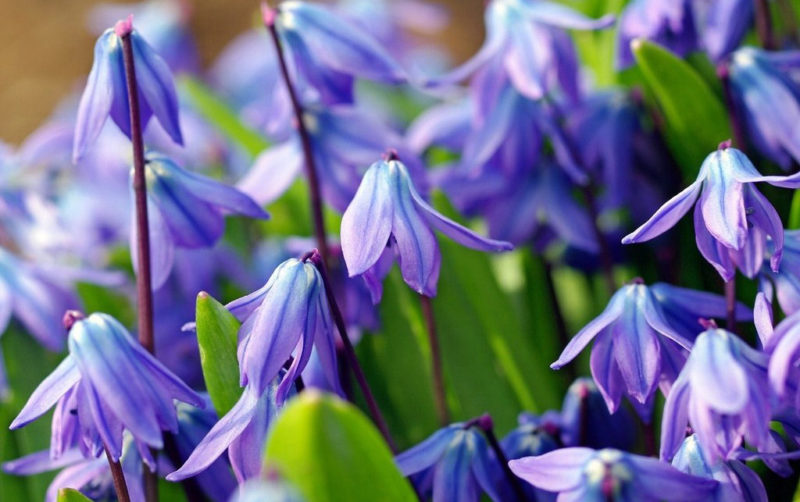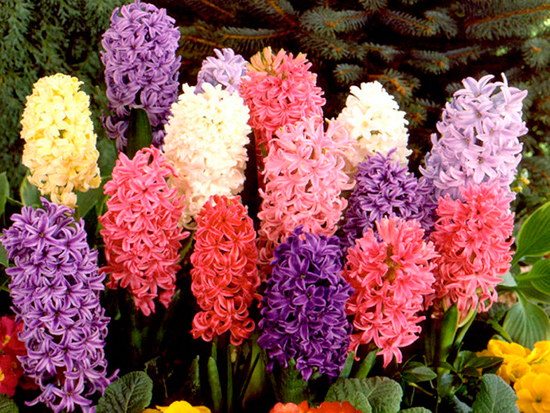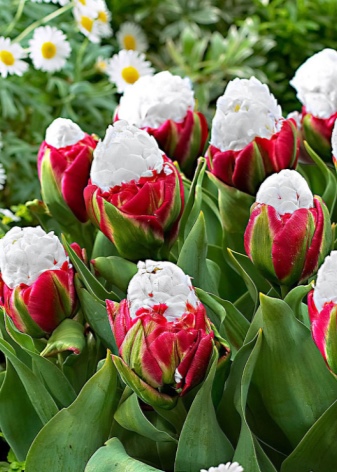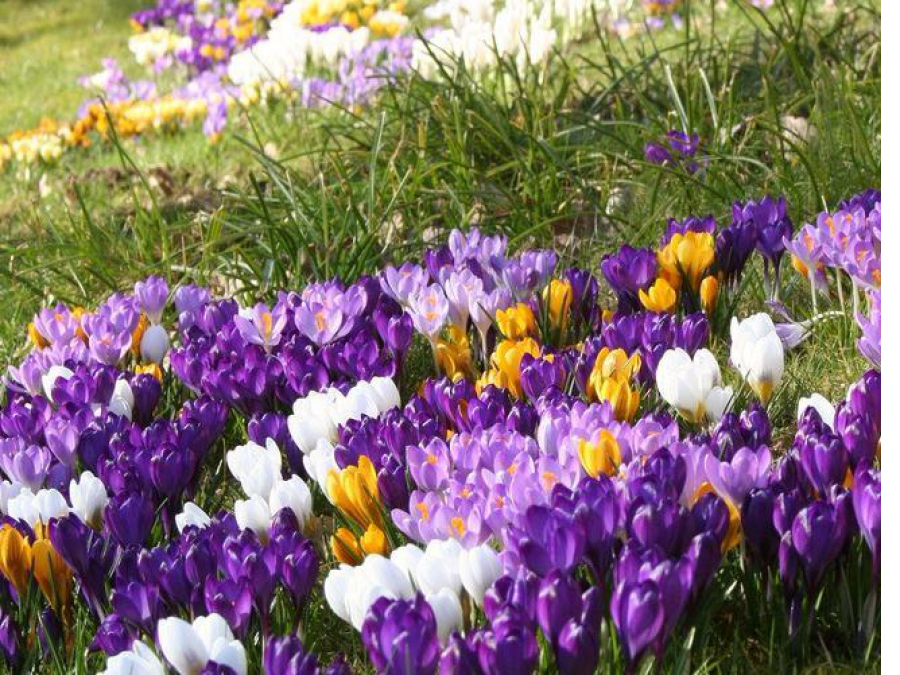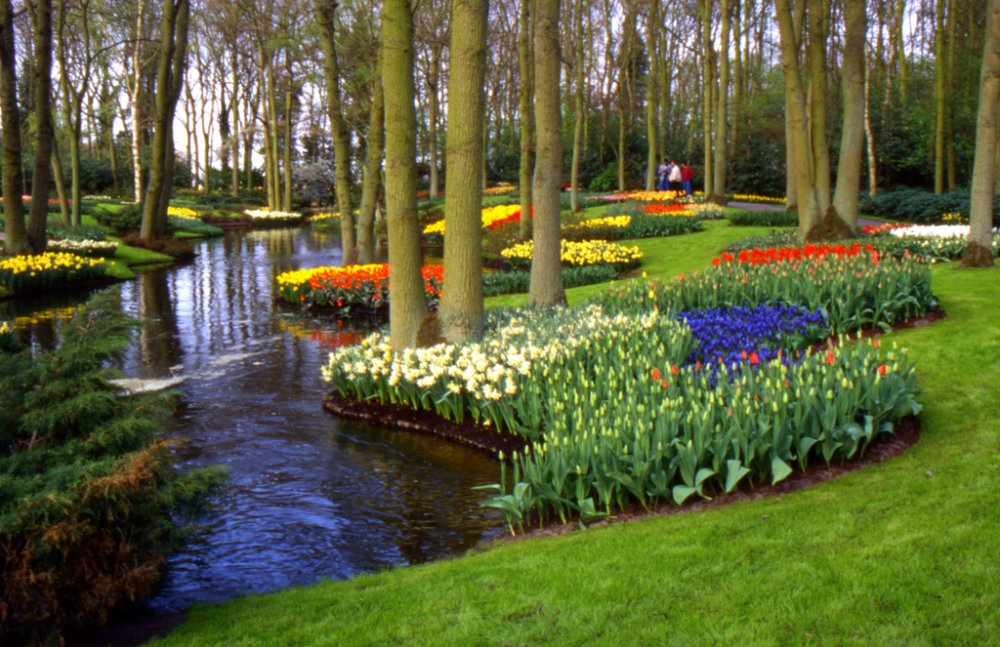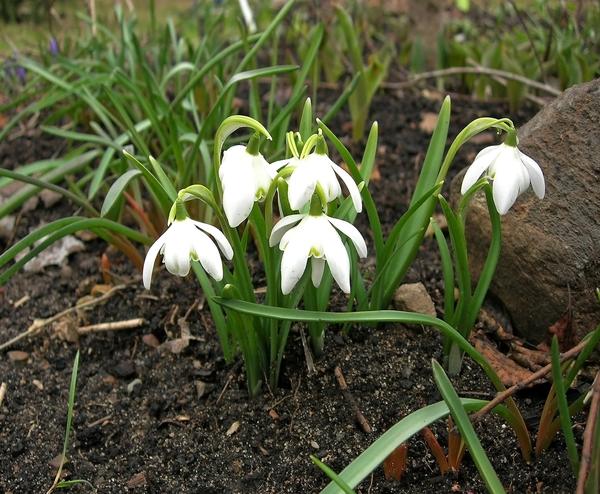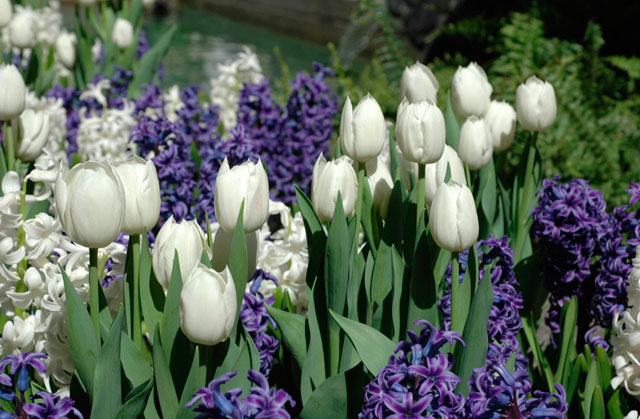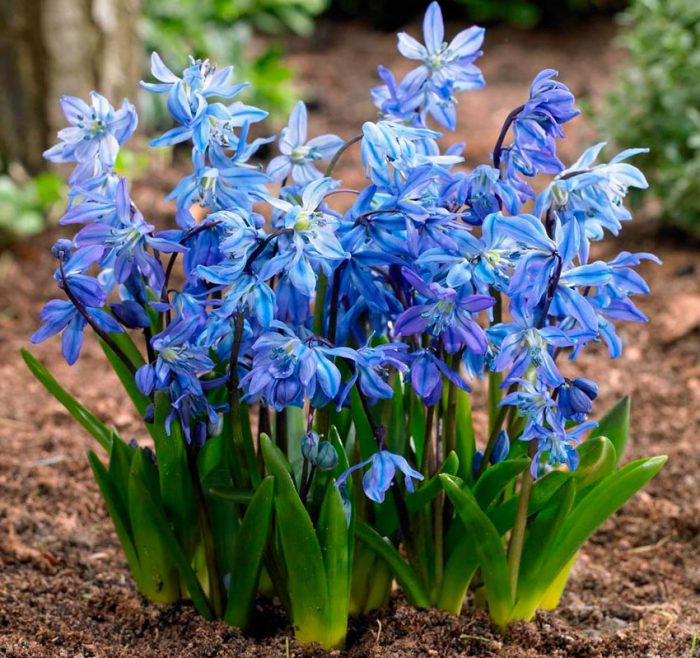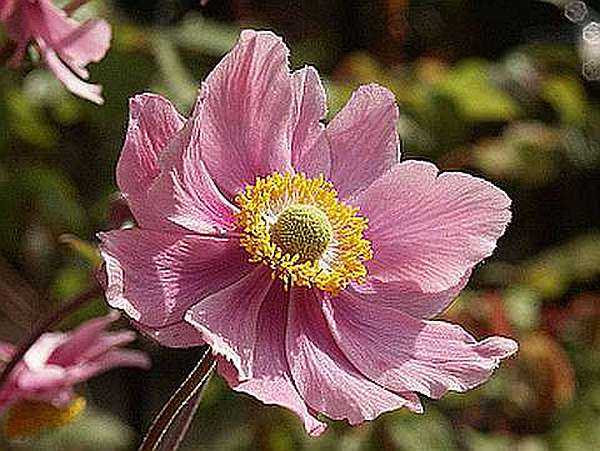Bulbous daffodil flower
The most famous and ubiquitous bulbous flower, the daffodil, is a great opportunity for early garden decoration.
NARCISSUS NARCISSUS (Variety N. 'Golden Harvest')
- Bloom time: March - April
- Location: sunny or slightly shady
- Reproduction: bulbs - children after digging


The term “tubular” usually refers to varieties that have flowers with a tube as long or longer than the petals, 15-45 cm high. 'King Alfred' was once dominant, but many other yellow varieties now exist. Let the leaves die naturally - don't tie them into knots.
NARCISSUS - NARCISSUS
- Bloom time: March - April
- Location: sunny or slightly shady
- Reproduction: bulbs - children after digging
Large-crowned. This includes varieties that have crowned flowers more than one third of the petal length and 30-60 cm high.
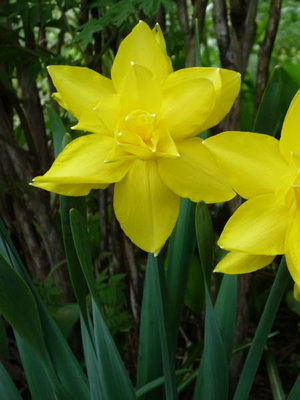

Popular variety 'Carlton' with large yellow flowers, 'Yellow Sun' is very early. There are completely white (‘Easter Moon’ and ‘Desdemona’), and two-color ones (‘Salome’).
NARCISSUS - NARCISSUS (Variety N. 'Thalia')
- Bloom time: March - April
- Location: sunny or slightly shady
- Reproduction: bulbs - children after digging
This includes all varieties not of the types previously described.


There are hundreds to choose from - Triandrus cultivars with more than one dangling flower on the stem, Cyclamen cultivars with only one dangling head, Poetic daffodils with red-bordered crowns, etc.
TULIP - TULIPA
- Flowering time: depends on the species
- Location: best sunny
- Reproduction: bulbs - children after digging
Garden tulips are types of plants that do not have a known specific parent and are planted in the fall and then dug up when the foliage turns yellow. Almost all bulbs in the catalogs are tulips. There are four main groups - early, late, large-flowered and unusual flowering varieties.
TULIP - TULIPA (T. Biflora cultivar)
- Flowering time: depends on the species
- Location: best sunny
- Reproduction: division in spring
These are specific tulips and hybrids of known species. Unlike garden tulips, they are usually left in the ground. There are a wide range of shapes and heights.

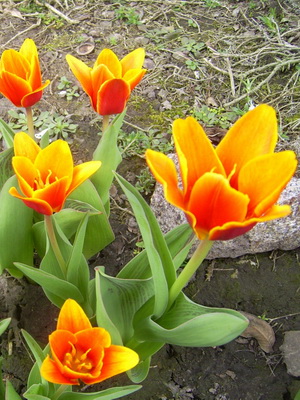
The well-known dwarf tulip T. biflora and Kaufman's tulip (T. kaufmanniana) and the taller Foster's tulip (T. fosteriana) and Greig's tulip (T. greigii).
BOW - ALLIUM
- Bloom time: May - July
- Location: best sunny
- Reproduction: division in the fall
Popular varieties belong to the group with spherical inflorescences of densely spaced flowers on vertical peduncles.


For the sake of really large inflorescences with a diameter of 20 cm, white-haired onion (A. albopilosum) is grown. Crested onions are smaller and have loose buds. Onions are sold as bulbs or vegetative plants.
Peculiarities
Many gardeners prefer to grow beautiful perennial flowers in their summer cottages that bloom throughout the summer season. Such "green pets" can be a wonderful decoration of the territory. The land planted with various perennials becomes brighter, "lively" and saturated. Different plants need different care. When grown correctly, they can be used to produce very spectacular landscape compositions that look great.
Many gardeners (especially beginners) are convinced that perennial plants in the garden need complex and constant care. In fact, among them there are a lot of species that are unpretentious and undemanding. Such varieties of perennials are becoming favorite among many gardening enthusiasts, since they are easy and simple to grow without spending a lot of time and effort. Perennial garden plants have many benefits. Let's get acquainted with them.
- For such flowers, there is no need to prepare seedlings in advance every year.Many of the perennial subspecies survive the winter season easily and without problems. Often, for the winter, they do not even have to be dug out beforehand.
- Regular transplanting to perennials is not important. They feel great in one place for 2-5 years. Thanks to this feature, gardeners have the opportunity to admire the beautiful flower arrangement for several years.
- Without buying fresh seeds and seedlings, gardeners can significantly save money. When growing, garden perennial plants themselves can give young seedlings, which can be used to decorate other areas in the garden. Some growers sell seedlings, making good money on this business.
- There is no need to wait for perfect weather conditions or the end of frost. Perennials are able to wake up on their own with the arrival of more comfortable environmental conditions.
- Differing from simple annuals, perennials have a longer flowering period. This is due to the fact that the rhizomes of the plants in question are in a hurry to prepare for the next flowering already in the fall.
Before rushing to planting perennial flowers in the garden, it is necessary to take into account not only their features, but also all the nuances of growing. We must not forget that each variety has its own characteristics and care requirements.
Selection of seeds for planting
Many perennial species grow from seeds. Unlike annual beauty, they can be planted all season. The absence of restrictions on the timing of planting is associated with a varied flowering period (from 2 to 6 years). When choosing seeds, you should take into account the characteristics of the region and the type of plant. Some species sprout directly in the ground, while others accept the first planting exclusively in a separate container.
Seedlings of delphinium, catchment, carnations are planted in March. Bell seeds are not dipped deep into the ground, leaving them in the light. Armeria must be pre-soaked in water for 10 hours. In May, June, you can sow perennials directly into the open ground. It should be remembered that the seeds of such plants quickly lose moisture and require daily watering. When choosing seeds, you should definitely know how to plant them.
You can use the following tips:
- Visual inspection. A hard shell indicates the need for germination in a warm place;
- Germination percentage. Each package of seeds has this information. This is very useful information for the gardener;
- Sorting before sowing. You can remove empty seeds by blowing on the spread out specimens. The empty ones will fly away from the air pressure;
- Hybrids or common varieties. If there is a need to harvest seeds, the first option is not suitable. Hybrid varieties, although they are distinguished by abundant flowering, are absolutely not suitable for seed production.
Varieties
Tall garden flowers are of different types and, accordingly, differ in flowering period. Most of them are summer blooming, decorating the garden with a riot of all kinds of colors. However, there are many tall flowers that bring a bright grace to the autumn landscape, in addition, they are quite frost-resistant. Among the tall varieties, there are a lot of unpretentious plants that do not require special care.

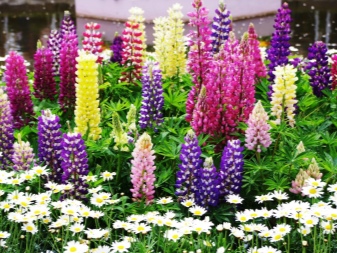
Blooming in summer
Consider the most popular tall crops that can decorate the site on summer days.
Aconite reaches 1.5 m in height. It blooms in blue, purple, white, yellow and pink tones.


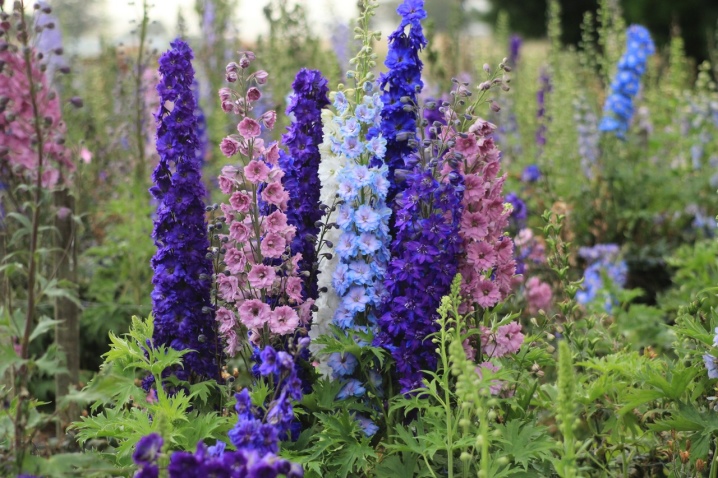


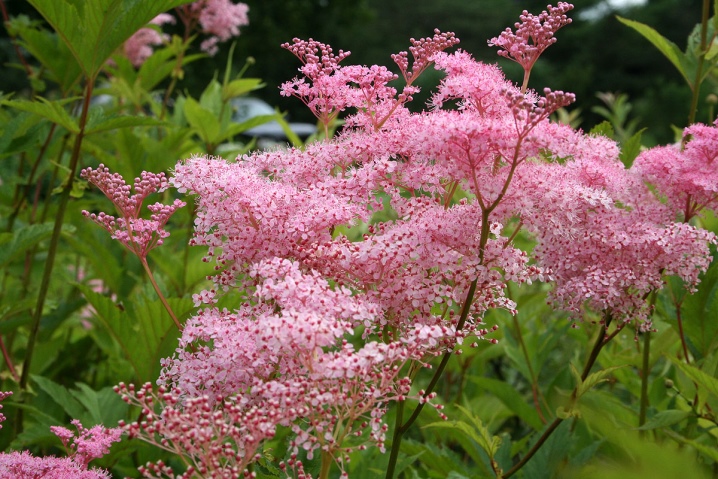

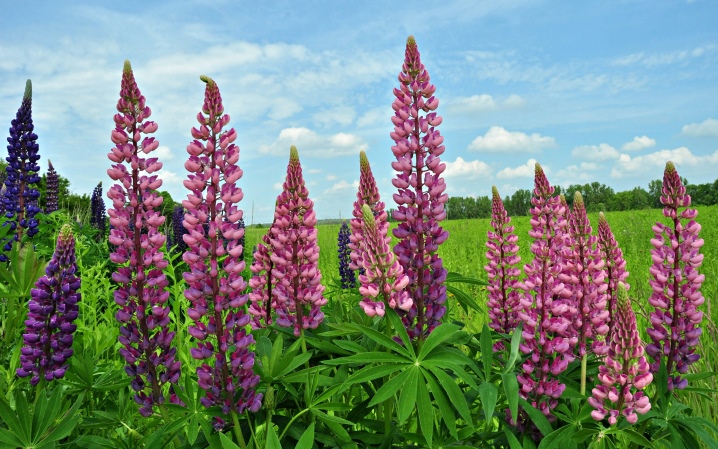


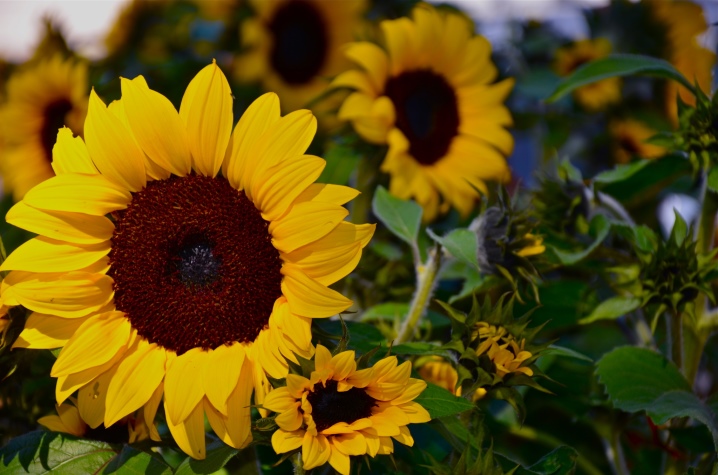


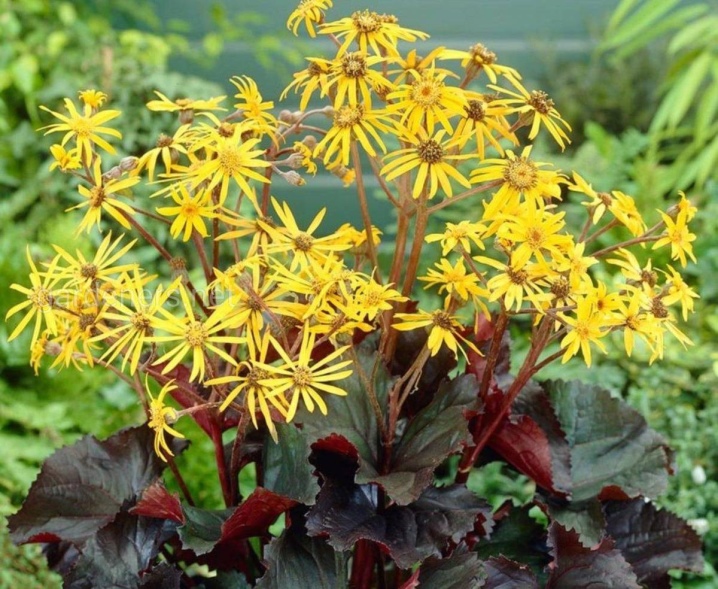


Blooming in autumn
Varieties that bloom in autumn seem to extend the summer on the site, they have their own beauty and sometimes look even more interesting than summer ones.
Astra New England has a bush size of up to 2 m. Not too large flowers have a blue, lilac-purple, pink color.


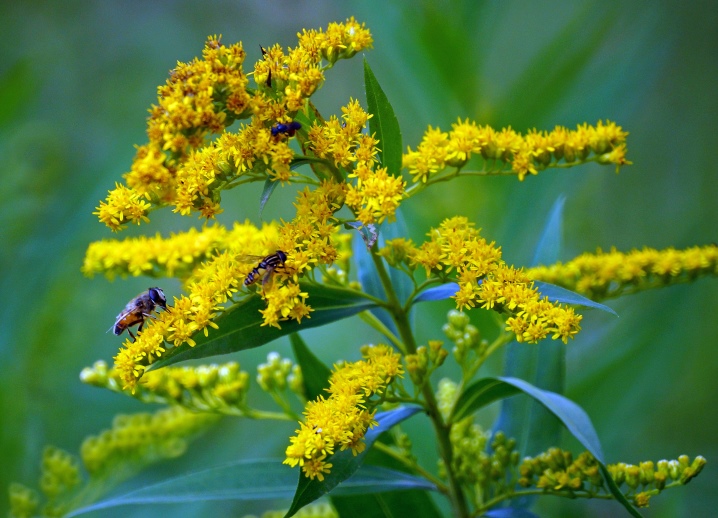

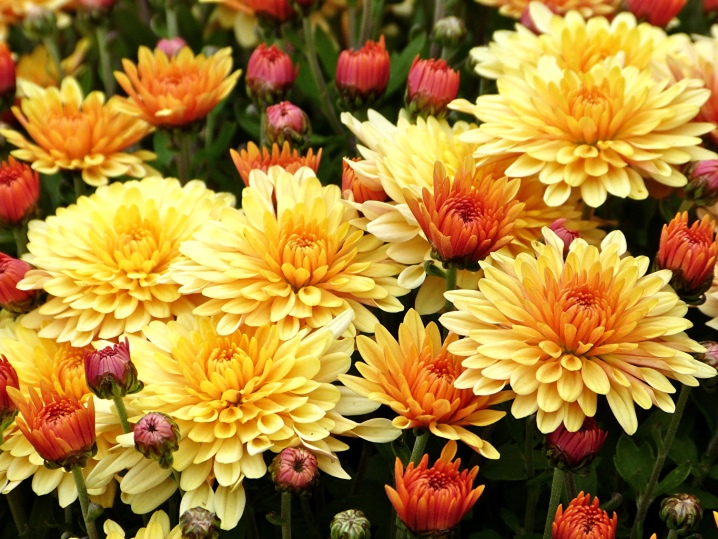

Unpretentious tall flowers
Such plants are most appreciated by gardeners for the fact that they do not require special care rules, but grow almost independently.
Volzhanka belongs to herbaceous perennials with large paniculate inflorescences, consisting of many tiny flowers of white or cream tone.


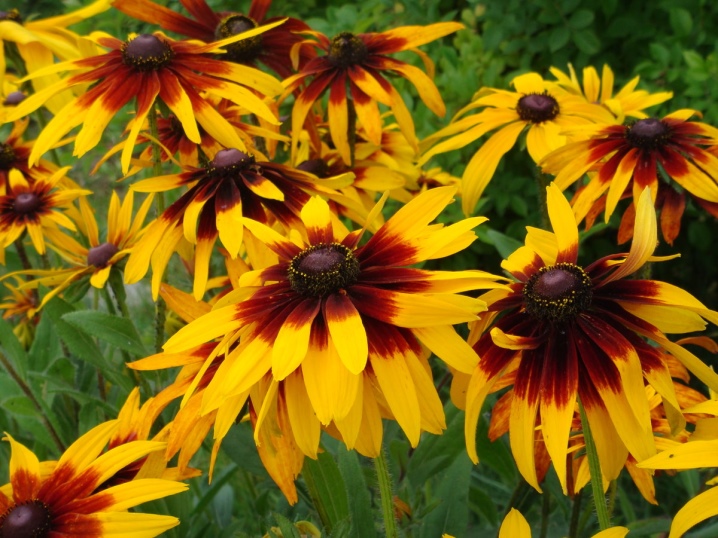


Tall flowers do not need special care, and most of them are generally unpretentious in maintenance. You just need to remember that many of them should be tied up, insofar as the stems cannot always support the weight of rather large buds. The best option in this case is nylon ties.
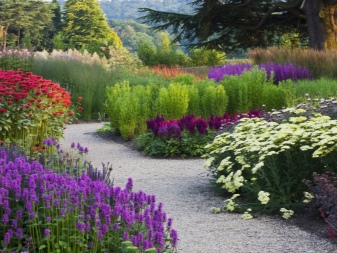

Features of autumn planting - pros, cons
Flowers planted in the autumn go through the most natural cycle of development, as there is a stratification of the planting material. Seeds that survived the winter, flower bulbs perfectly tolerate short spring frosts, begin flowering a little earlier than others, cope better with invasions of pests, all kinds of diseases.
When planting in late autumn, you do not have to spend a month or two on growing seedlings, and an excellent result - a lush flower bed, will appear much earlier than in spring. Perennials planted on the eve of winter, during the period of cold weather, are sufficiently tempered, they release shoots, leaves, flowers faster in spring. Many flowering plants bloom most profusely during the autumn planting, as they manage to take root in the fall.
Another important argument in favor of planting in the fall is that a florist can devote more time to choosing plants, think over what and where to plant. In addition, the autumn soil warmed up by the sun is much easier to dig up, and frequent autumn rains make it possible to do practically without "manual" watering.
There are also some disadvantages of winter landings. During winter, early spring thaws, seeds, plant bulbs are able to wake up and die with the repeated onset of cold weather. With a not too deep planting and severe frosts, some of the plantings die, but in the spring it is easy to notice and duplicate it in the right places in a timely manner.
How to register?
Rockery can serve as one of the design options for a flower garden. It is a small plot of about 5-6 sq. m, where ornamental plants are planted among the stones. This is an interesting design option for suburban and suburban areas, gardens and parks.
Rockeries will look especially good with natural uneven terrain. Depending on the location on such flower beds, both sun-loving plants (sedum, styloid phlox, armeria, irises, primroses, obriety, dicenter) and shade-tolerant plants (kupen, aquilegia, etc.) are planted.

Vesnarius is a small, cheerful garden with spring bulbous, corms and rhizome plants. Snowdrops are the earliest of all to grow on the islands open to the sun, followed by crocuses, scillas, corydalis and chionodox. Then come muscari, hyacinths, daffodils and tulips. Even later, subulate phlox, aubrieta, liverwort, viola, forget-me-not and daisy bloom.
Alpine slide - a site set aside for mountain plants. On such a site, paths are arranged, terraces and stairs are made. The elements of equipment can be stones, reservoirs with waterfalls, streams. Plants grown on alpine slides are considered unpretentious. The following spring plants are recommended for the rock garden: subulate phlox, periwinkle, aubrieta, gentian, etc.


Field paints
Field paints
Despite their modesty, wildflowers are no less beloved by gardeners. They give the flower beds a natural look.
Field crops on the territory give their advantages:
- the flowerbed looks more attractive and vital, because bees, butterflies begin to visit it
- thanks to naturalness, a cozy and unique atmosphere is created
- in most cases, these plants are medicinal, which can be very useful
Sage
Sage
Medicinal plant. Even in combination with other colors, it does not lose its individuality and attractiveness. Grows well under any conditions and soil composition.
Liatris
Liatris
Liatris
A flower of tenderness and romance. It also has properties that have many benefits. He looks very colorful. Caring for him is not difficult. Has a pleasant aroma. Creates a perfect combination in a group with other flowers and in border plantings.
Yarrow
Yarrow
Yarrow
Possesses many wonderful qualities:
- perfectly decorates the flower garden
- looks beautiful in a bouquet on the table
- due to its medicinal properties, it should be in every first-aid kit
Gardeners also love this plant because it is unpretentious in care, blooms for a long time and abundantly.
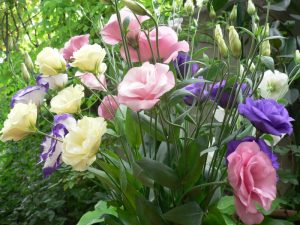
Eustoma flower (Lisianthus) (100 Photos) - planting and care at home. An extraordinary plant in your garden + Reviews
September
September colorful landscape
The difference between September and other summer months is insignificant. the weather is not much different. Obvious changes appear in the last days of the month.
At the beginning of the fall, there are still many flowering summer plants. But they are very sensitive to cold weather, a small amount of sunlight and because of this, their flowering ends quickly. They are replaced by September flowers, which bloom in the autumn. Thanks to this, the colorful floral carpet at the summer cottage remains for a long time.
Asters
Asters
They bloom profusely and for a long time. For this reason, they are popular. There are many varieties that bloom in September and October. They are also varied in their size, splendor of flowering and colors.
Caring for asters is simple. Reproduction is easy. They are not afraid of a slight cold snap. Abundant flowering decorates the garden with its variegation for a very long time. Sometimes the bush is so covered with flowering buds that the leaves are almost invisible.
There are annual and perennial varieties.
Dahlias
Dahlias
Excellent decoration of the suburban area. Can grow in shaded areas with almost any soil composition. They love moisture, although an excess of it is not desirable.
There are the most common types:
- anemic
- collar
- nymph
- peony
- spherical
- needle-like
Currently, there are about 20,000 varieties.
The characteristic features are:
- the form
- terry
- length (10-12 cm)
It will look more advantageous if you arrange these flowers as a framing of the path, as a decorating element of parterres and composite flower beds against the background of the grass cover.
Rudbeckia hairy
Rudbeckia hairy
Rudbeckia hairy
Few people do not know the bright yellow and orange flowers with a brown center. They are similar to daisies, only multi-colored and large in size. Grown as an annual flower because it is the flowering of the first year that is the most charming, and in the future its decorative appearance is quickly lost or the plant completely dies.
The trunk of the plant is straight. Its surface, like the foliage cover, is elastic and rough. The length of the trunk is 45-65 cm. Rudbeckia blooms for a long time (before the onset of the first frosts).
Refers to unpretentious plants. Prefers good moisture and fertilized soil. Can grow in shaded areas.
Looks great in combination with coniferous plants, in rockeries and against the background of a green lawn carpet.
Majors (zinnia graceful)
Majors (zinnia graceful)
Majors (zinnia graceful)
Perennial flower. Its trunk is smooth, reaching a height of 20-90 cm. The foliage is bright green, small in size. Its shape is heart-shaped. The inflorescence, located on an elongated peduncle, has a splendor.
In shape, the flower resembles a basket with a tiled arrangement of petals with edges concave inward. Its diameter is about 10 cm.
For good development, the following conditions are preferable:
- nutrient soil
- well lit location
- wind proof
Chrysanthemums
Chrysanthemums
More often known under another name - oaks. They will beautify any landscape. They have a large variety of varieties.They differ in height, size, and many colors of flowers. In shape, the inflorescences are similar to asters.
The open sun is not harmful for the plant. Prefers rich, moderately moist soil. The flowering period for chrysanthemums is the end of summer - all autumn.
Of all the species, the Korean chrysanthemums are the most popular. They are unassuming. Small flowers literally shower the entire bush.
Also, recently, oak trees can be seen more and more often, which have a surprisingly regular, spherical shrub appearance and lush flowering. This beauty is called a spherical chrysanthemum. Its height is no more than 0.5 m. Flowers of this species are medium-sized, double or semi-double, with a wide variety of colors.
This shrub chrysanthemum is especially undemanding to the conditions in which it develops. The flowering period is from August to November. It also multiplies easily: by cuttings, dividing the bush and root system.
Also, plants that bloom in early autumn include:
- gladioli
- anemone
- sunflower decorative
- balsam
- tuberous begonia
- Cannes
- geranium
- chrysanthemum
- marigold
- ornamental cabbage
- Jerusalem artichoke
- fuchsia
- perennial cornflower
- phlox
- echinacea
This is just a small list of all the types, with the help of which the territory will acquire a colorful and joyful appearance.
Aglaonema: description, home care, reproduction, varieties (100+ Photos & Videos) + Reviews
Preparing for winter
The onset of winter in color
If perennial crops are planted for flower decoration of the territory, then they must be prepared for winter.
First of all, plants that are not dug up for the winter are cut off. This is done so that with the onset of spring, young shoots do not interfere with growth. When pruning dried stems, a small part of them with leaves is left. These processes will accumulate nutrients that the plant will need for development for the next year. After the pruning procedure, the ground around the plant needs loosening and feeding (humus, compost).
Also, preparation for the winter period consists of the following actions:
- Planting of bulbous species (daffodils, tulips, crocuses). It is better to do this at the end of the summer period - the beginning of the fall. If the action took place at a later date, the planting is covered with foliage, straw or dry twigs
- Perennial plants (irises, phloxes, primroses) are divided before the cold weather sets in.
- Seeds are collected from annual species (asters, marigolds). They will be used next year
- When the temperature drops from 0 ... + 5C, clematis take cover. The easiest way to do this is to wrap their own shoots.
- The green part is cut off from the peonies, the earth around is loosened, sprinkled with ash
- Before the onset of frost, roses are piled up (with peat, sand). They take refuge after the onset of frost
- In the late autumn period, summer plants are sown. Their seeds should have time to swell, but germination should not occur. They will sprout with the arrival of spring after the snow melts.
Autumn flowers in the garden
After completing all of the above work before the first snow falls, the flower garden will be fully prepared for winter.
The names of flowers described in the article are only a small part, the flowering of which begins in autumn or does not end when the cold weather has already arrived. In fact, there are a lot of species that are unpretentious and frost-resistant. But do not rush and plant all the flowers available just because they will bloom for a very long time.
There will be enough of several types that can decorate the territory in the country. They should not only be pleasing to the eye, but, preferably, that they should be easy to care for. Autumn time is when all the work is completed, and a well-equipped flower garden will allow you to enjoy the effort spent and have fun with joy.
Garden flowers in September. My autumn garden
Autumn flowers in the garden: catalog with photos and names | TOP-30 Best
10
Total Score
Autumn flowers (photos and names)
Did our article help you?
10
|
Caring for perennial bulbous garden flowers
When caring for bulbous flowers, watering should be moderate, as well as fertilization. Do not fertilize bulbous organics, it is better to use mineral fertilizers. After flowering, when the stems turn yellow, cut the plants to soil level. In fact, most bulbs do not need to be dug up, the only exceptions are tulips, and even then not all. Moreover, this condition is not as categorical as it is often believed. Even those tulips that need to be dug out can be left in place for 2-3 years. Bulbous plants do not cover for the winter, they are all exceptionally frost-resistant. The exception is only in the year of planting, while only spunbond rags are enough for insulation. Do not be alarmed by spring frosts: bulbous ones can easily withstand temperatures down to 7 degrees below zero.
Below you can see the photo of bulbous garden flowers and the table "Bulbous for your garden":
| Liatris | May 5-12 | Bulbs |
Sunny place, nutritious soil |
| Montbrecia (crocosmia) | May 1-9 | Bulbs | Sunny place, nutritious soil. Does not like thickening by other plants. Good drainage is essential |
| Gladioli | Late April - early May | Bulbs | Sunny place or partial shade, nutritious soil. Good drainage is a must! |
| Dahlias | After May 15 (start growing on April 3-8) | Grown root-tubers | Sunny place, nutritious soil, better loam. Good drainage is a must! |
| Spring bulbous (tulips, daffodils, crocuses, muscari, quinodoxa, blueberry, etc.) | In autumn, from September 20 to October 8. Small-bulbous plants are planted first, tulips last | Bulbs in open ground | Any place, any soil. Avoid stagnant water. Top dressing only with mineral fertilizers |
| Summer bulbous (decorative bows, etc.) | In the spring, May 1-10 | Bulbs in open ground | Sun or partial shade, any soil. Avoid stagnant water. Fertilizing with mineral fertilizers |
Varieties of flower beds
- A flower border in the form of a line 10-30 cm wide from one or more rows of flowers is a common design option for a flower bed. Low compact flowering plants are suitable for such a flower garden. It is used to give clarity to ridges, mixborders, groups, flower beds, etc.
- Rabatka is a strip 50-100 cm wide, completely planted with flowers. Such a flower garden is made in the form of a certain pattern with alternating colors in appearance and color. They are located along paths, fences, reservoirs.
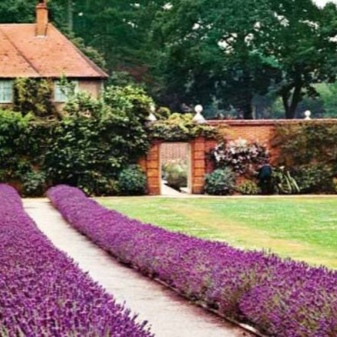

- Solitaire are free standing plants. Tall plants-accents (peonies, hazel grouses, dicenters) are used for specimen plantings. Spectacular tapeworms accentuate other, lower plants, create volume. Solitary tapeworms look great on green lawns.
- Group - free picturesque planting of flowers on an area of two to thirty square meters. Such landings are placed inside the designated area. The contours of the group are made sinuous. Groups can be simple (from one plant species) or complex (from several).
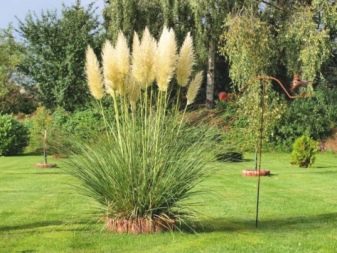
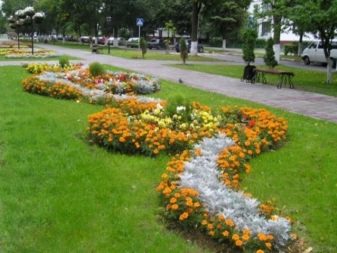
- A flower bed is a regular-shaped area planted with ornamental plants. Most often, flower beds are made in parks, in front of administrative buildings, in city squares. A flower bed can be from one type of plant, or several.
- Mixborder is a mixed discount. It is a picturesque strip 2-4 m wide, filled with decorative deciduous and flowering plants, located in spots or geometric patterns. The mixborder can be of irregular oblique shape.






